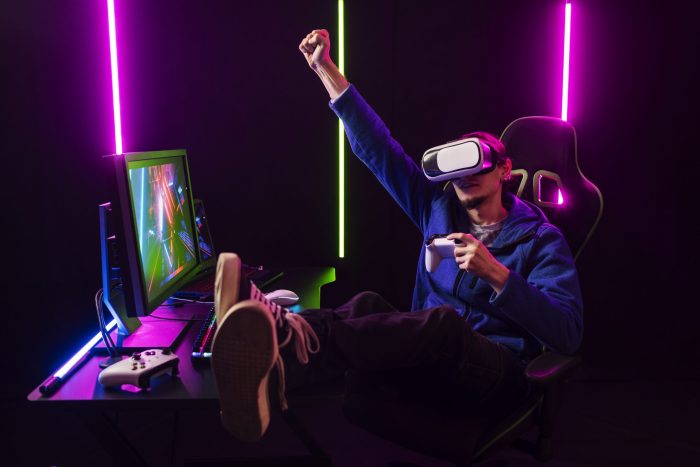
In the last few years, the gaming industry has undergone a seismic shift. No longer confined to screens and consoles, games have begun expanding into immersive, persistent, and interconnected digital worlds known collectively as the Metaverse. This isn’t just another gaming trend—it’s a technological revolution that could reshape how we play, socialize, and even earn a living.
In this article, we’ll break down what Metaverse gaming is, how it works, the technologies powering it, and why it’s poised to redefine the future of entertainment.
What Is Metaverse Gaming?
Metaverse gaming refers to interactive, 3D virtual environments where players can explore, socialize, and engage in activities beyond traditional gameplay. Unlike standard video games, these worlds are often persistent—meaning they continue to exist and evolve even when you log off.
Players are represented by avatars and can interact with others in real time, often blending gaming, social networking, and digital commerce. In many cases, these worlds are built on blockchain technology, enabling the creation and trade of unique virtual assets like skins, weapons, land, and collectibles.
Key Features That Define Metaverse Gaming
While the concept can vary from one platform to another, most metaverse games share common traits:
1. Persistent Worlds
Metaverse games exist independently of player activity. Your character, possessions, and the world itself continue to evolve even when you’re not online.
2. Interoperability
Some platforms are working toward allowing players to transfer digital items between different games or worlds—meaning your sword from one fantasy game could be used in a sci-fi environment.
3. Social Interaction
Voice chat, text messaging, and even virtual concerts or events are integrated into these platforms, making them more like digital societies than just games.
4. Player-Driven Economies
Many metaverse games use cryptocurrencies and NFTs (non-fungible tokens) to allow players to buy, sell, or trade in-game items for real-world value.
The Technology Powering the Metaverse
The rise of Metaverse gaming is fueled by advancements in multiple cutting-edge technologies:
- Virtual Reality (VR): Provides an immersive first-person experience inside the virtual world.
- Augmented Reality (AR): Overlays digital elements on the real world for hybrid experiences.
- Blockchain: Ensures secure ownership of virtual assets and facilitates decentralized economies.
- Artificial Intelligence (AI): Powers dynamic NPC behavior and personalizes game experiences.
- Cloud Computing: Enables massive multiplayer environments without requiring expensive hardware.
Without the combination of these innovations, the dream of persistent, interconnected gaming worlds would be nearly impossible.
Popular Examples of Metaverse Games
While the metaverse is still developing, several platforms already offer fully realized virtual worlds:
- Roblox: Known for its user-generated games and events, attracting millions of players daily.
- Decentraland: A blockchain-based world where users can own land, build structures, and host events.
- The Sandbox: Another blockchain-driven platform emphasizing creative freedom and asset ownership.
- Fortnite: Evolved from a battle royale game into a virtual space hosting concerts, movie screenings, and social hangouts.
These games are just the beginning—many tech giants are investing heavily to expand the metaverse ecosystem.
How Metaverse Gaming Changes the Player Experience
The leap from traditional gaming to the metaverse changes not just how we play, but how we relate to games:
- From Playing to Living in the Game – Instead of completing a set storyline, you’re part of an evolving world where your actions shape the environment.
- More Than Entertainment – Virtual worlds can be used for education, business, and cultural events.
- Ownership and Investment – Players can genuinely own and trade digital assets, giving them real-world economic value.
Opportunities and Benefits
Metaverse gaming offers both casual players and serious gamers a wealth of opportunities:
- Economic Potential: Play-to-earn (P2E) models allow players to generate income.
- Creativity: Users can design their own games, buildings, and interactive experiences.
- Global Communities: Play and interact with people from all over the world without geographic limits.
- Cross-Industry Applications: Brands, musicians, and artists are using metaverse games to connect with audiences in innovative ways.
Challenges and Concerns
Despite its potential, Metaverse gaming faces challenges that must be addressed:
- High Entry Costs: VR headsets and powerful computers can be expensive.
- Scams and Fraud: The integration of crypto and NFTs increases the risk of financial exploitation.
- Regulation: Governments are still figuring out how to handle ownership, taxation, and content moderation.
- Addiction Risks: The immersive nature of these platforms may encourage overuse.
Addressing these issues will be crucial for healthy long-term growth.
The Future of Metaverse Gaming
Over the next decade, we can expect the boundaries between games, social media, and e-commerce to blur further. Improvements in VR and AR hardware will make virtual experiences more lifelike, while faster internet and cloud gaming will bring these worlds to more people.
We may also see Metaverse gaming merge with artificial intelligence to create worlds that adapt in real time to each player’s actions and preferences. Imagine a game that changes its storyline based on your decisions, relationships, and past adventures—essentially creating a personalized digital universe.
Final Thoughts
The rise of Metaverse gaming marks a turning point in the evolution of digital entertainment. More than just a new genre, it represents a shift toward persistent, immersive, and player-driven worlds that combine gaming, social interaction, and commerce in ways we’ve never seen before.
While there are still hurdles to overcome, the potential is too great to ignore. As technology advances and adoption grows, these virtual worlds may become as familiar and essential as today’s social media platforms—only far more interactive and engaging.

